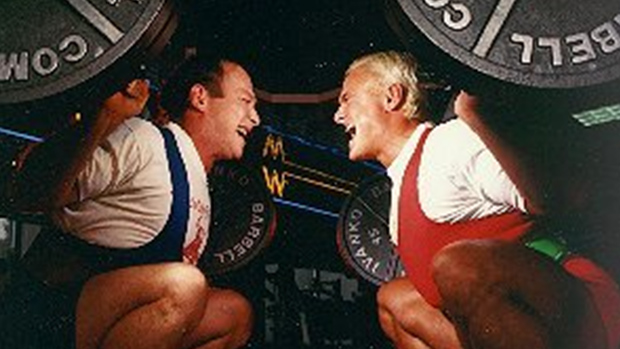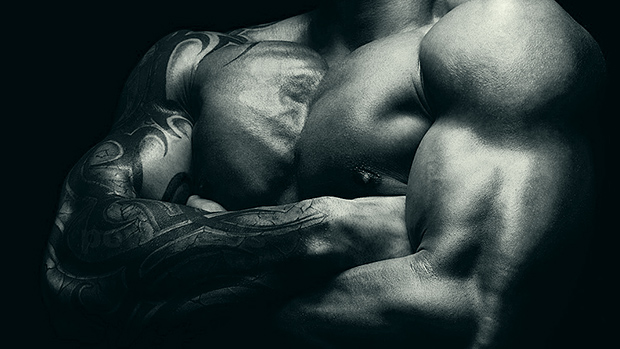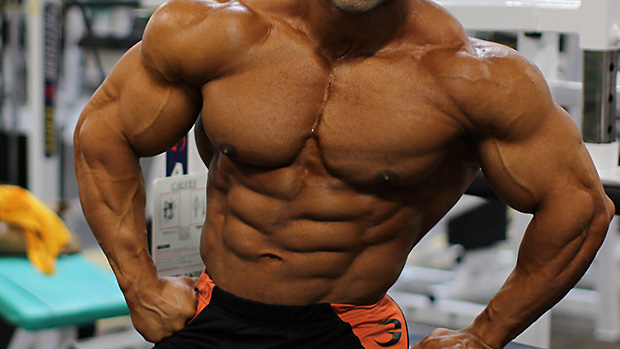Few lifters stress over the nuances of performing the perfect shrug, which may explain why the exercise is often so poorly executed by gym folk. And that's a shame.
The basic "shrug" targets the upper trapezius, and involves elevating the shoulders while holding either a barbell or dumbbells. While the movement is about as old as they come, the recent corrective-exercise trend has resulted in the shrug being labeled as dangerous, leaving it on the outside looking in.
While it's true the upper trapezius is often over-developed in trainees, meaning additional work could potentially lead to shoulder and neck issues, there's more to shrugs than just targeting the upper traps.
Shrugs also involve scapula retraction and depression, i.e., the shoulder girdle movement that pull the shoulders back and down. This is a big deal, as the shoulder blades influence the health and performance of the shoulders similar to how the glutes influence the knees and lower back. It's all about function in several planes.
Yes to Shrugs
Every upper body pull and push, whether vertical or horizontal, depends on shoulder health and performance. You can't maximize your shoulders' artillery without creating a stable base, which in this case is the correct positioning of the shoulder blades.
The muscles responsible for this action are primarily the trapezius and rhomboids, hence you need to build strength and mass in those areas in order to develop formidable pressing power.
For example, during a bench press or chin-up, have you ever noticed that one or both of your shoulders shrugged up towards your ears, leading you to miss the lift?
In the beginning this is often just a technical flaw that can easily be fixed, but as you get stronger and loads increase, the problem gets worse. It gets to the point where you can no longer rely on the quick fix, and require strength development in certain stabilizing muscles. Let's take a close look at what has to be done.
- Bench Press: During the bench press you have to pull the shoulder blades down and back to create a solid base. If this fails to happen, chances are you won't press in a straight line, creating unnecessary and potentially dangerous shoulder rotation, not to mention missed lifts and possible pain down the road.
- Shoulder Press: During the shoulder press, you want to avoid elevating the shoulders. While you can (and in some cases, might want to do this), it's safer to depress the shoulder blades while pressing. To accomplish this, think about pushing yourself away from the bar and into the ground like a wedge. This will instantly make you stronger and help keep your shoulders healthy.
- Rows: In a lot of rowing variations, novice trainees will often substitute correct shoulder positioning with too much momentum, thereby letting the shoulders creep up to the ears. Don't do this. It's better to target the muscles you want to train rather than just heave some heavy weight around.
- Chins and Pulldowns: Many lifters will let their shoulders creep up towards their ears while performing chin-ups, usually after fatigue sets in or when using heavy loads. This is compensation, and don't let it happen – it's like benching with the shoulders elevated. Tissues that don't need stress will be stressed with this "technique."
The Point?
So shrugs suck and we shouldn't do them? Not quite. Although the upper trapezius muscles are already worked a lot during the typical training session, the traps still need focused retraction and depression work to prevent the aforementioned imbalances.
Exercises That Make It Happen!
Kelso Shrug
This exercise targets the rhomboids and middle/lower traps exceptionally well. Lie face down on an incline bench with your chest supported and feet firmly planted on the ground. Be sure to create a stable base with your feet.
With an underhand, shoulder-width grip, grab the bar and lift it by pinching the shoulder blades down and back as hard as possible. Focus on achieving a hard contraction of the lower traps – try to "break the bar" by externally rotating the arms. This makes the shoulder blades come together nicely.
Kelso Shrug With Dumbbells
This is the same as the previous movement, but with dumbbells. Extend the upper back and focus on contracting the lower traps through external rotation of the hands/arms.
Standing Neck Supported Barbell Shrug
Standing with the neck supported on a bench, shrug the shoulders back and down. Use an underhand grip for better activation. I like this variation as you get a little neck stabilization as well.
Standing Kettlebell Shrug
Since compensation patterns typically come from one side being weaker than the other, there's also a place for unilateral shrug training. If you know you have a weaker side, simply add a specific shrug variation to that side to fix the issue.
A standing one-arm shrug with a kettlebell is very effective. Hold onto a bench to stabilize the upper body, making sure to stand wide enough to create a stable base. Keep the back extended and pull the shoulder blade back and down. Use an incline or flat bench to target different areas and to learn stabilization of the scaps in different angles.
Chin-Up Shrug
Most people perform chin-ups without any conscious effort to first get into a stable shoulder position, which can reduce the efficiency of the exercise. Again, you need to create a stable base, which requires a conscious muscle contraction.
Take an overhand or parallel grip on a chin-up bar. From there, lean back, raise your chest using the thoracic spine as a fulcrum, and pull the shoulder blades down and back. It helps to try to "break" the bar apart here as well. This exercise also works tremendously well to correct trouble with arching during the bench press.
Inverted Shrug
The inverted row is an awesome exercise, but just like chin-ups, many people tend to miss a critical point – a stable and healthy positioning of the shoulders. Retraction of the shoulders is critical for effective rows, but overlook scapula depression and say hello to shoulder and neck trouble.
Get in the standard position for performing inverted rows, but instead of pulling all the way, just focus on the retraction and depression of the shoulder blades while keeping the chest high and your neck neutral.
Just as with the chin-up variation, think of the thoracic spine as a fulcrum. This exercise works great as a "filler" between sets of bench presses as it mimics what's done during the bench press setup.
Seated Cable Shrug
For this exercise, start in the regular seated row position while making sure the back is arched and the chest pushed up. From here, squeeze the shoulder blades together. By focusing on pushing the chest up and out, the shoulder blades are more easily depressed.
How to Incorporate Shrugs
We know the rhomboids and middle/lower traps must be developed for optimal health and performance. Regular exercises can be enough in developing them, but often you hear reactions from clients and athletes such as "I only feel my biceps working" after performing exercises like rows, chin-ups, etc.
The problem is often either technical flaws or the muscles you "feel" doing the work are too strong (relatively speaking) and are overpowering the movement, the latter usually a result of the former.
Often rows, chin-ups, and pulldowns lead to increased biceps soreness and little in the way of lats, rhomboids, and lower traps involvement. Fortunately, shrugs can help address this.
Warm-up / Fillers
If you don't need to focus on the traps and rhomboids but just want to make sure they perform properly, just include a shrugging movement in your warm-up routine. You can either perform the exercise for 3-5 reps of 5-second isometric holds, or do regular sets of 8-12 repetitions. Volume depends on exercise, load, and purpose. For warm-ups, 1-2 sets are enough. As a filler, perform them after each set of one of your main exercises.
Pre-Exhaust
Since the weakest link in a given movement tends to take most of the work, we can easily make a regular exercise more traps and rhomboids-intensive by using the pre-exhaust method.
Choose a shrug exercise and perform 8-12 reps, then immediately perform the normal upper back movement of you choice. So, after a Kelso shrug, perform regular chest supported rows, etc. This redistributes the load in favor of stimulating the rhomboids and traps.
Post-exhaust
Post-exhaust is another option to target the areas. Immediately after performing rows, chin-ups, or pulldowns, do the shrug version of the exercise – either static holds for 5 seconds per rep, or straight sets of 8-12 repetitions. Three to 5 sets are usually enough.
Let's Finish
The standard "3 sets of shrugs" to finish off a back or shoulder workout is either woefully inadequate or downright counter-productive – not a good outlook for any physique-minded athlete.
It's time to start assessing what the body truly needs versus what we've always just done. In this case, that means looking at shrugs in a whole new light.
It may not be as exciting as your bench or squat workouts, but it helps develop a rock-solid foundation on which you can build on. And that's the kind of thinking that separates the lifelong lifters from the flash-in-the-pan warriors.




